HONDA PASSPORT 2001 2.G User Guide
Manufacturer: HONDA, Model Year: 2001, Model line: PASSPORT, Model: HONDA PASSPORT 2001 2.GPages: 317, PDF Size: 4.85 MB
Page 11 of 317
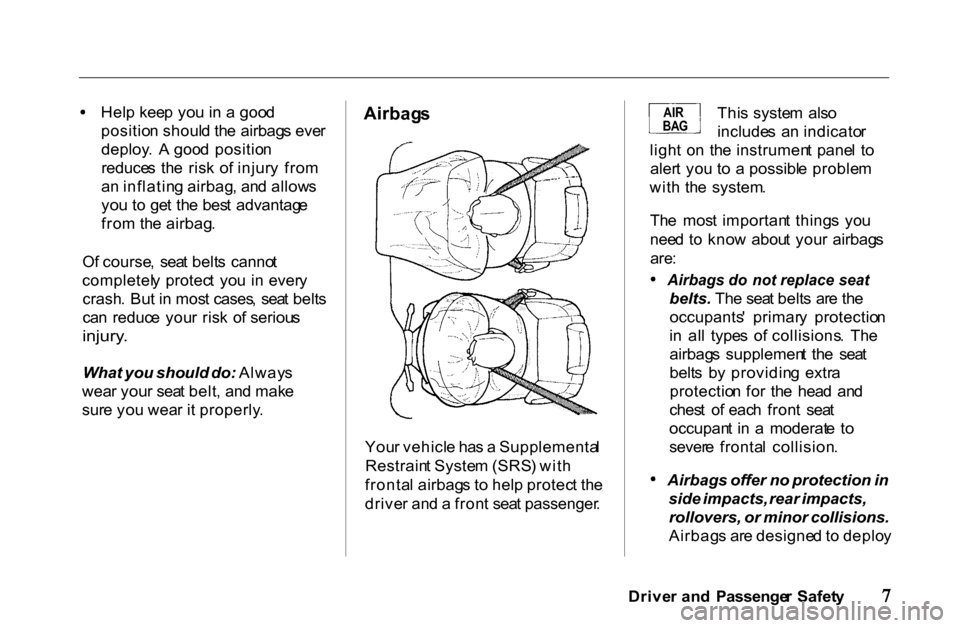
Hel
p kee p yo u in a goo d
positio n shoul d th e airbag s eve r
deploy . A goo d positio n
reduce s th e ris k o f injur y fro m
a n inflatin g airbag , an d allow s
yo u t o ge t th e bes t advantag e
fro m th e airbag .
O f course , sea t belt s canno t
completel y protec t yo u i n ever y
crash . Bu t i n mos t cases , sea t belt s
ca n reduc e you r ris k o f seriou s
injury .
What you should do: Always
wea r you r sea t belt , an d mak e
sur e yo u wea r i t properly .
Airbag
s
You r vehicl e ha s a Supplementa l
Restrain t Syste m (SRS ) wit h
fronta l airbag s t o hel p protec t th e
drive r an d a fron t sea t passenger . Thi
s syste m als o
include s a n indicato r
ligh t o n th e instrumen t pane l t o
aler t yo u t o a possibl e proble m
wit h th e system .
Th e mos t importan t thing s yo u
nee d t o kno w abou t you r airbag s
are :
Airbags
do not replace seat
belts. The sea t belt s ar e th e
occupants ' primar y protectio n
i n al l type s o f collisions . Th e
airbag s supplemen t th e sea t
belt s b y providin g extr a
protectio n fo r th e hea d an d
ches t o f eac h fron t sea t
occupan t i n a moderat e t o
sever e fronta l collision .
Airbags offer no protection in
side impacts, rear impacts,
rollovers, or minor collisions.
Airbag s ar e designe d to deplo y
Drive r an d Passenge r Safet y
AI
R
BA G
Page 12 of 317
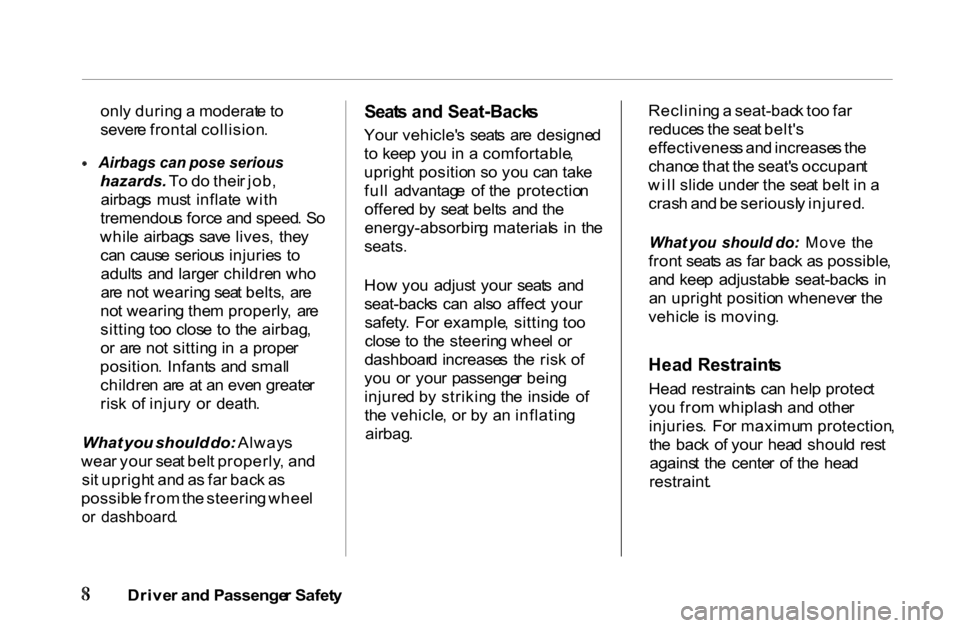
onl
y durin g a moderat e to
sever e fronta l collision .
Airbags
can pose serious
hazards. To d o thei r job ,
airbag s mus t inflat e wit h
tremendou s forc e an d speed . S o
whil e airbag s sav e lives , the y
ca n caus e seriou s injurie s t o
adult s an d large r childre n wh o
ar e no t wearin g sea t belts , ar e
no t wearin g the m properly , ar e
sittin g to o clos e t o th e airbag ,
o r ar e no t sittin g in a prope r
position . Infant s an d smal l
childre n ar e a t a n eve n greate r
ris k o f injur y o r death .
What you should do: Always
wea r you r sea t bel t properly , an d
si t uprigh t an d a s fa r bac k a s
possibl e fro m th e steerin g whee l
o r dashboard .
Seat
s an d Seat-Back s
You r vehicle' s seat s ar e designe d
t o kee p yo u in a comfortable ,
uprigh t positio n s o yo u ca n tak e
ful l advantag e o f th e protectio n
offere d b y sea t belt s an d th e
energy-absorbin g material s i n th e
seats.
Ho w yo u adjus t you r seat s an d
seat-back s ca n als o affec t you r
safety . Fo r example , sittin g to o
clos e t o th e steerin g whee l o r
dashboar d increase s th e ris k o f
yo u o r you r passenge r bein g
injure d b y strikin g th e insid e o f
th e vehicle , o r b y a n inflatin g
airbag .
Reclinin
g a seat-bac k to o fa r
reduce s th e sea t belt' s
effectivenes s an d increase s th e
chanc e tha t th e seat' s occupan t
wil l slid e unde r th e sea t bel t i n a
cras h an d b e seriousl y injured .
What you should do: Mov e th e
fron t seat s a s fa r bac k a s possible ,
an d kee p adjustabl e seat-back s i n
a n uprigh t positio n wheneve r th e
vehicl e i s moving .
Hea d Restraint s
Hea d restraint s ca n hel p protec t
yo u fro m whiplas h an d othe r
injuries . Fo r maximu m protection ,
th e bac k o f you r hea d shoul d res t
agains t th e cente r o f th e hea d
restraint .
Drive r an d Passenge r Safet y
Page 13 of 317
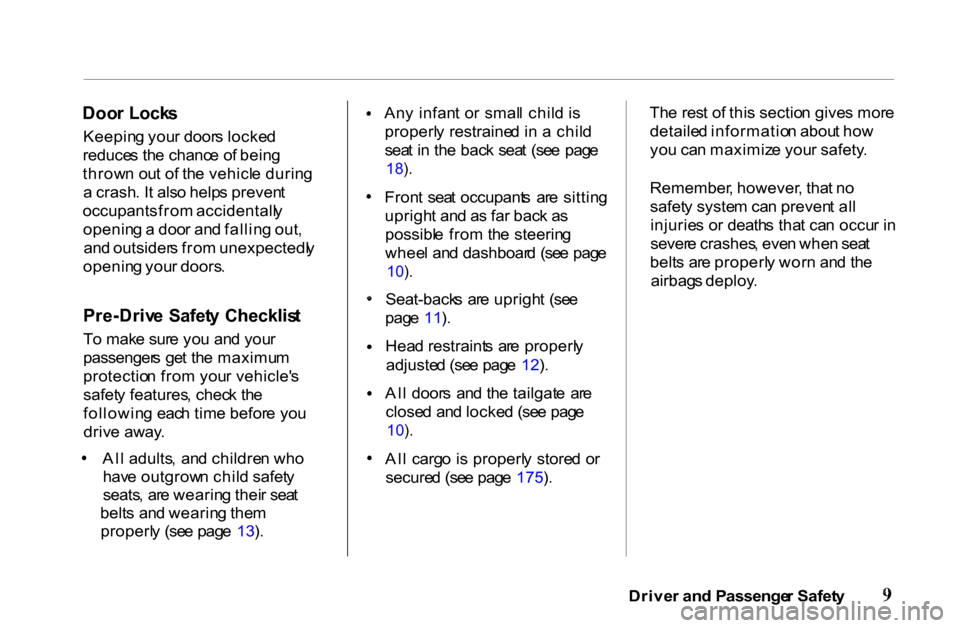
Doo
r Lock s
Keepin g you r door s locke d
reduce s th e chanc e o f bein g
throw n ou t o f th e vehicl e durin g
a crash . I t als o help s preven t
occupants from accidentall y
openin g a doo r an d fallin g out ,
an d outsider s fro m unexpectedl y
openin g you r doors .
Pre-Driv e Safet y Checklis t
T o mak e sur e yo u an d you r
passenger s ge t th e maximu m
protectio n fro m you r vehicle' s
safet y features , chec k th e
followin g eac h tim e befor e yo u
driv e away .
Al l adults , an d childre n wh o
hav e outgrow n chil d safet y
seats , ar e wearin g thei r sea t
belt s an d wearin g the m
properl y (se e pag e 13 ). An
y infan t o r smal l chil d is
properl y restraine d in a chil d
sea t i n th e bac k sea t (se e pag e
18 ).
Fron t sea t occupant s ar e sittin g
uprigh t an d a s fa r bac k a s
possibl e fro m th e steerin g
whee l an d dashboar d (se e pag e
10 ).
Seat-back s ar e uprigh t (se e
pag e 11 ).
Hea d restraint s ar e properl y
adjuste d (se e pag e 12 ).
Al l door s an d th e tailgat e ar e
close d an d locke d (se e pag e
10 ).
Al l carg o i s properl y store d o r
secure d (se e pag e 175 ). Th
e res t o f thi s sectio n give s mor e
detaile d informatio n abou t ho w
yo u ca n maximiz e you r safety .
Remember , however , tha t n o
safet y syste m ca n preven t al l
injurie s o r death s tha t ca n occu r i n
sever e crashes , eve n whe n sea t
belt s ar e properl y wor n an d th e
airbag s deploy .
Drive r an d Passenge r Safet y
Page 14 of 317
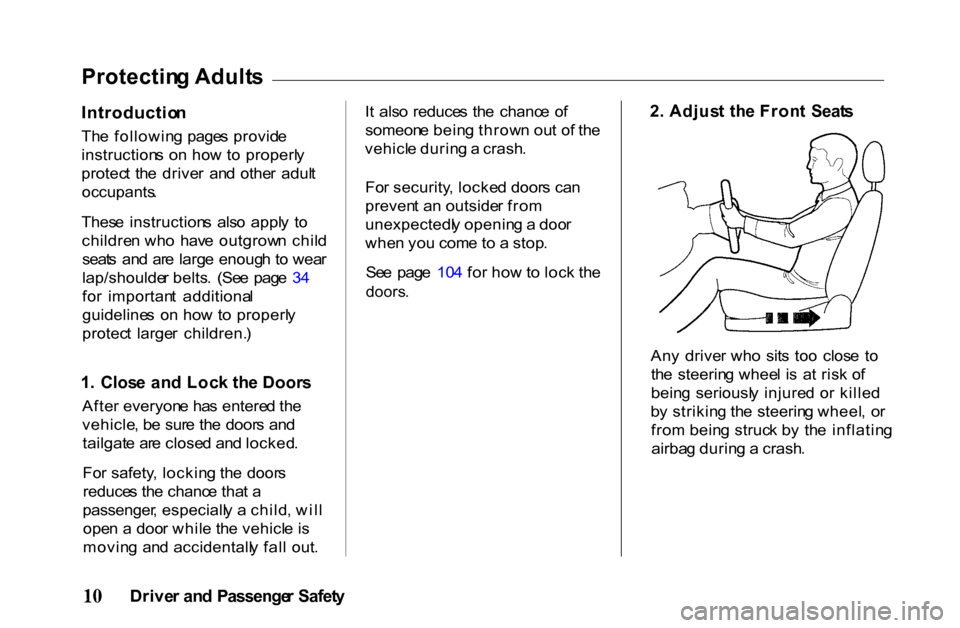
Protectin
g Adult s
Introductio n
Th e followin g page s provid e
instruction s o n ho w to properl y
protec t th e drive r an d othe r adul t
occupants .
Thes e instruction s als o appl y t o
childre n wh o hav e outgrow n chil d
seat s an d ar e larg e enoug h t o wea r
lap/shoulde r belts . (Se e pag e 3 4
fo r importan t additiona l
guideline s o n ho w to properl y
protec t large r children. )
1 . Clos e an d Loc k th e Door s
Afte r everyon e ha s entere d th e
vehicle , b e sur e th e door s an d
tailgat e ar e close d an d locked .
Fo r safety , lockin g th e door s
reduce s th e chanc e tha t a
passenger , especiall y a child , wil l
ope n a doo r whil e th e vehicl e is
movin g an d accidentall y fal l out . I
t als o reduce s th e chanc e o f
someon e bein g throw n ou t o f th e
vehicl e durin g a crash .
Fo r security , locke d door s ca n
preven t a n outside r fro m
unexpectedl y openin g a doo r
whe n yo u com e t o a stop .
Se e pag e 10 4 fo r ho w to loc k th e
doors .
2
. Adjus t th e Fron t Seat s
An y drive r wh o sit s to o clos e t o
th e steerin g whee l i s a t ris k o f
bein g seriousl y injure d o r kille d
b y strikin g th e steerin g wheel , o r
fro m bein g struc k b y th e inflatin g
airba g durin g a crash .
Drive r an d Passenge r Safet y
Page 15 of 317
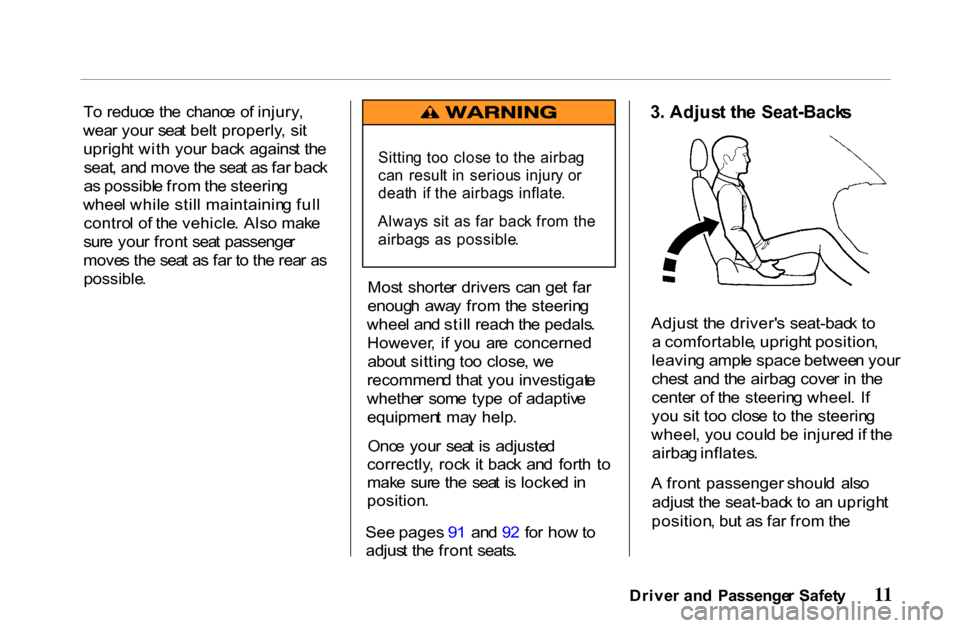
T
o reduc e th e chanc e o f injury ,
wea r you r sea t bel t properly , si t
uprigh t wit h you r bac k agains t th e
seat , an d mov e th e sea t a s fa r bac k
a s possibl e fro m th e steerin g
whee l whil e stil l maintainin g ful l
contro l o f th e vehicle . Als o mak e
sur e you r fron t sea t passenge r
move s th e sea t a s fa r t o th e rea r a s
possible .
Most shorte r driver s ca n ge t fa r
enoug h awa y fro m th e steerin g
whee l an d stil l reac h th e pedals .
However , i f yo u ar e concerned
abou t sittin g to o close , w e
recommen d tha t yo u investigat e
whethe r som e typ e o f adaptiv e
equipmen t ma y help .
Onc e you r sea t i s adjuste d
correctly , roc k i t bac k an d fort h t o
mak e sur e th e sea t i s locke d in
position .
See pages 9 1 an d 9 2 fo r ho w to
adjus t th e fron t seats .
3
. Adjus t th e Seat-Back s
Adjus t th e driver' s seat-bac k t o
a comfortable , uprigh t position ,
leavin g ampl e space betwee n you r
ches t an d th e airba g cove r i n th e
cente r o f th e steerin g wheel . I f
yo u si t to o clos e t o th e steerin g
wheel , yo u coul d b e injure d if th e
airba g inflates .
A fron t passenger should als o
adjus t th e seat-bac k t o a n uprigh t
position , bu t a s fa r fro m th e
Drive r an d Passenge r Safet y
Sittin
g to o clos e t o th e airba g
ca n resul t i n seriou s injur y o r
deat h i f th e airbag s inflate .
Alway s si t a s fa r bac k fro m th e
airbag s a s possible .
Page 16 of 317
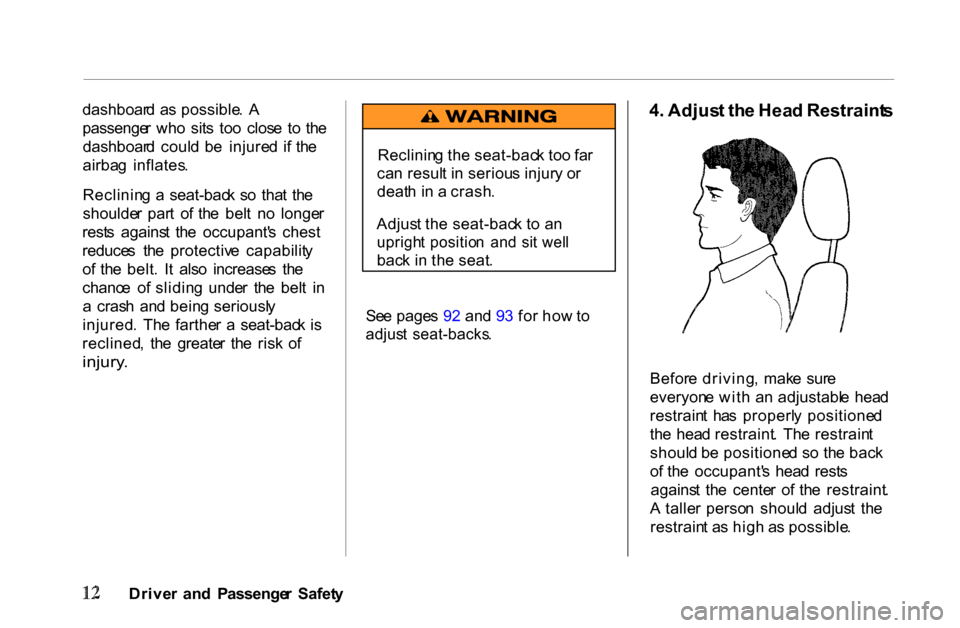
dashboar
d a s possible . A
passenge r wh o sit s to o clos e t o th e
dashboar d coul d b e injure d i f th e
airba g inflates .
Reclinin g a seat-bac k s o tha t th e
shoulde r par t o f th e bel t n o longe r
rest s agains t th e occupant' s chest
reduce s th e protectiv e capabilit y
o f th e belt . I t als o increase s th e
chanc e o f slidin g unde r th e bel t i n
a cras h an d bein g seriousl y
injured . Th e farthe r a seat-bac k i s
reclined , th e greate r th e ris k o f
injury .
Se
e page s 9 2 an d 9 3 fo r ho w to
adjus t seat-backs .
4
. Adjus t th e Hea d Restraint s
Befor e driving , mak e sur e
everyon e wit h a n adjustabl e hea d
restrain t ha s properl y positione d
th e hea d restraint . Th e restrain t
shoul d b e positione d s o th e bac k
o f th e occupant' s hea d rest s
agains t th e cente r o f th e restraint .
A talle r perso n shoul d adjus t th e
restrain t a s hig h a s possible .
Drive r an d Passenge r Safet y Reclinin
g th e seat-bac k to o fa r
ca n resul t i n seriou s injur y o r
deat h in a crash .
Adjus t th e seat-bac k t o a n
uprigh t positio n an d si t wel l
bac k i n th e seat .
Page 17 of 317
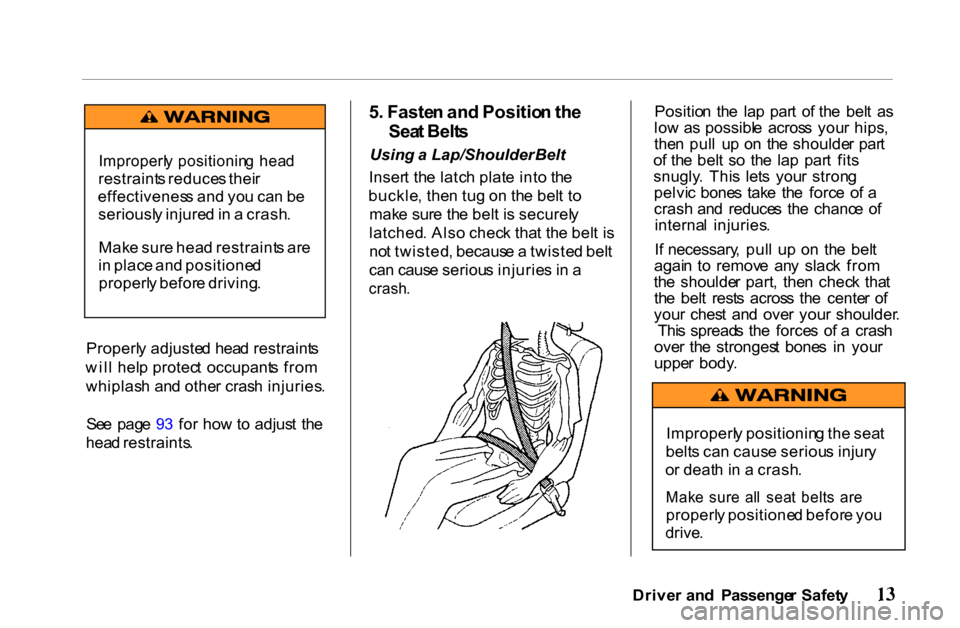
Properl
y adjuste d hea d restraint s
wil l hel p protec t occupant s fro m
whiplas h an d othe r cras h injuries .
Se e pag e 9 3 fo r ho w to adjus t th e
hea d restraints . 5
. Faste n an d Positio n th e
Sea t Belt s
Using a Lap/Shoulder Belt
Inser t th e latc h plat e int o th e
buckle , the n tu g o n th e bel t t o
mak e sur e th e bel t i s securel y
latched . Als o chec k tha t th e bel t i s
no t twisted , becaus e a twiste d bel t
ca n caus e seriou s injurie s in a
crash .
Positio
n th e la p par t o f th e bel t a s
lo w a s possibl e acros s you r hips ,
the n pul l u p o n th e shoulde r par t
o f th e bel t s o th e la p par t fit s
snugly . Thi s let s you r stron g
pelvi c bone s tak e th e forc e o f a
crash and reduce s th e chanc e o f
interna l injuries .
I f necessary , pul l u p o n th e bel t
agai n t o remov e an y slac k fro m
th e shoulde r part , the n chec k tha t
th e bel t rest s acros s th e cente r o f
you r ches t an d ove r you r shoulder .
Thi s spread s th e force s o f a cras h
ove r th e stronges t bone s i n you r
uppe r body .
Drive r an d Passenge r Safet y
Improperl
y positionin g hea d
restraint s reduce s thei r
effectivenes s an d yo u ca n b e
seriousl y injure d in a crash .
Mak e sur e hea d restraint s ar e
i n plac e an d positione d
properl y befor e driving .
Improperly positionin g th e sea t
belt s ca n caus e seriou s injur y
o r deat h in a crash .
Mak e sur e al l sea t belt s ar e
properl y positione d befor e yo u
drive .
Page 18 of 317
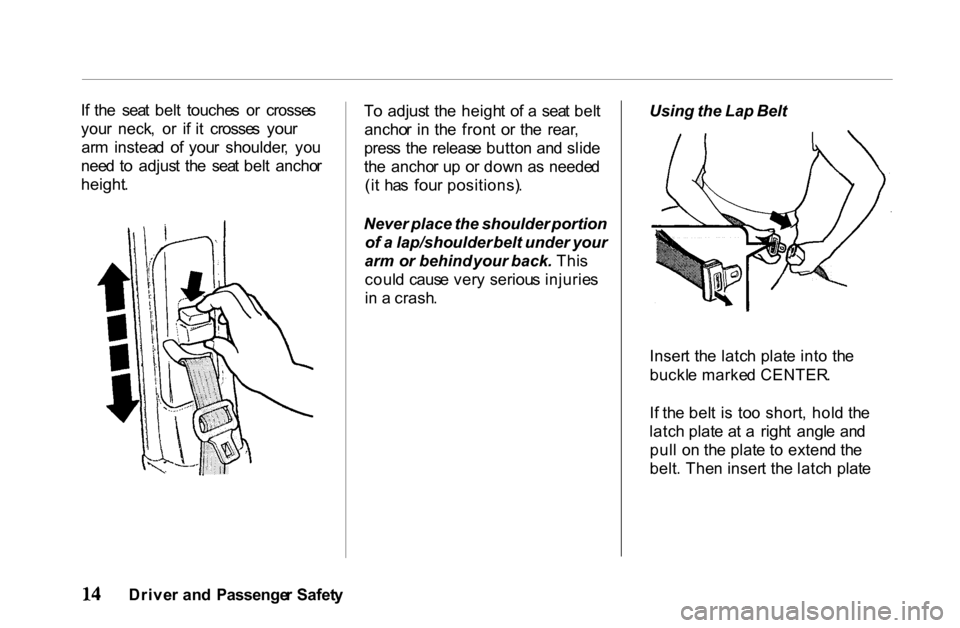
I
f th e sea t bel t touche s o r crosse s
you r neck , o r i f i t crosse s you r
ar m instea d o f you r shoulder , yo u
nee d t o adjus t th e sea t bel t ancho r
height . T
o adjus t th e heigh t o f a sea t bel t
ancho r i n th e fron t o r th e rear ,
pres s th e releas e butto n an d slid e
th e ancho r u p o r dow n a s neede d
(i t ha s fou r positions) .
Never place the shoulder portion
of a lap/shoulder belt under your
arm or behind your back. This
coul d caus e ver y seriou s injurie s
i n a crash . Using
the Lap Belt
Inser t th e latc h plat e int o th e
buckl e marke d CENTER .
I f th e bel t i s to o short , hol d th e
latc h plat e a t a righ t angl e an d
pul l o n th e plat e t o exten d th e
belt . The n inser t th e latc h plat e
Drive r an d Passenge r Safet y
Page 19 of 317
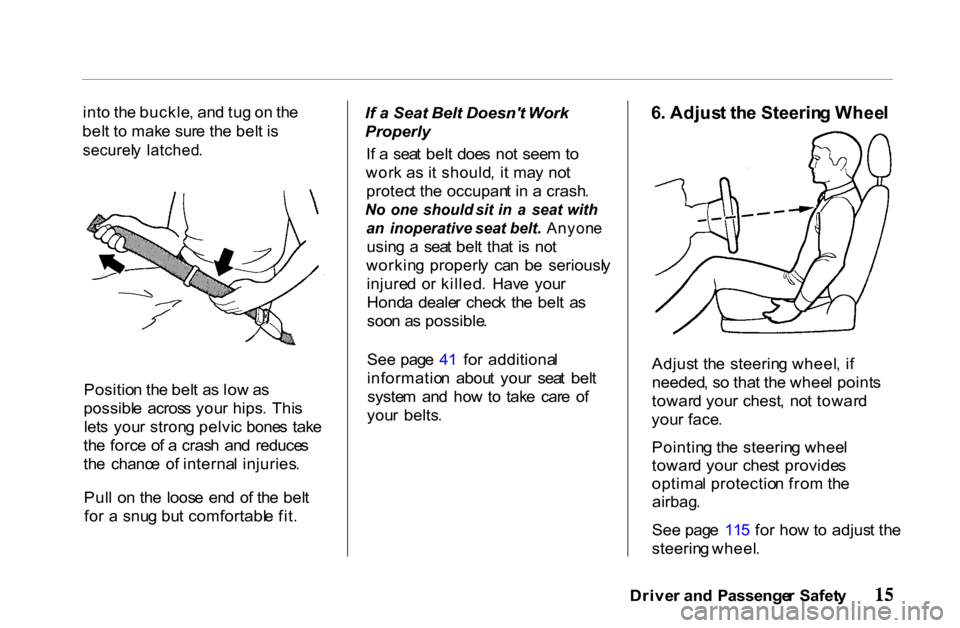
int
o th e buckle , an d tu g o n th e
bel t t o mak e sur e th e bel t i s
securel y latched .
Positio n th e bel t a s lo w a s
possibl e acros s you r hips . Thi s
let s you r stron g pelvi c bone s tak e
th e forc e o f a cras h an d reduce s
th e chanc e o f interna l injuries .
Pul l o n th e loos e en d o f th e bel t
fo r a snu g bu t comfortabl e fit . If
a Seat Belt Doesn't Work
Properly
I f a sea t bel t doe s no t see m to
wor k a s i t should , i t ma y no t
protec t th e occupan t i n a crash .
No one should sit in a seat with
a n inoperative seat belt. Anyon e
usin g a sea t bel t tha t i s no t
workin g properl y ca n b e seriousl y
injure d o r killed . Hav e you r
Hond a deale r chec k th e bel t a s
soo n a s possible .
See pag e 4 1 fo r additiona l
informatio n abou t you r sea t bel t
syste m an d ho w to tak e car e o f
you r belts .
6
. Adjus t th e Steerin g Whee l
Adjus t th e steerin g wheel , i f
needed , s o tha t th e whee l point s
towar d you r chest , no t towar d
you r face .
Pointin g th e steerin g whee l
towar d you r ches t provide s
optima l protectio n fro m th e
airbag .
See pag e 11 5 fo r ho w to adjus t th e
steerin g wheel .
Drive r an d Passenge r Safet y
Page 20 of 317
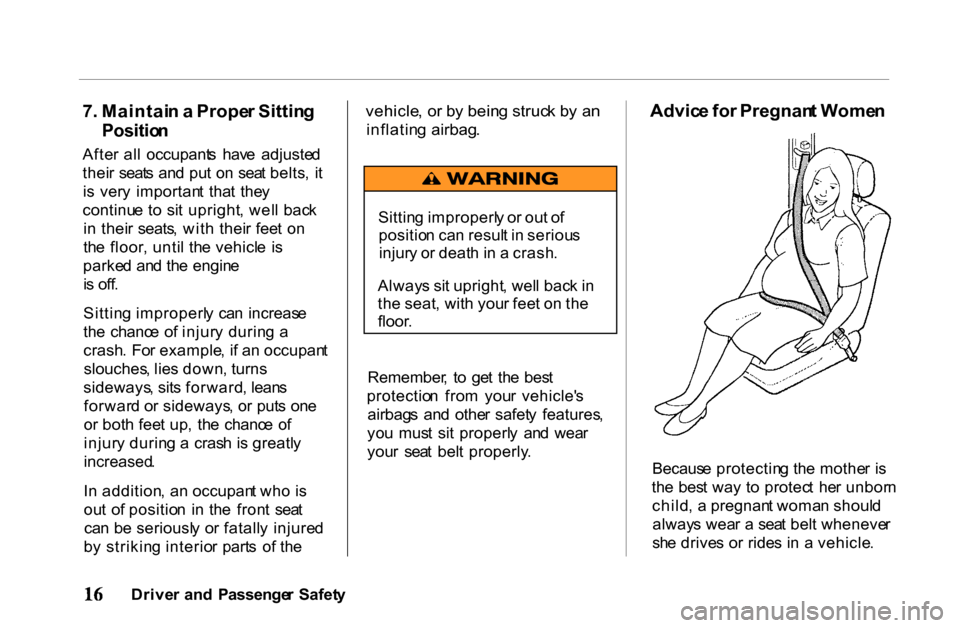
7
. Maintai n a Prope r Sittin g
Positio n
Afte r al l occupant s hav e adjuste d
thei r seat s an d pu t o n sea t belts , i t
i s ver y importan t tha t the y
continu e t o si t upright , wel l bac k
i n thei r seats , wit h thei r fee t o n
th e floor , unti l th e vehicl e i s
parke d an d th e engin e
i s off .
Sittin g improperl y ca n increas e
th e chanc e o f injur y durin g a
crash . Fo r example , i f a n occupan t
slouches , lie s down , turns
sideways , sit s forward , lean s
forwar d o r sideways , o r put s on e
o r bot h fee t up , th e chanc e o f
injur y durin g a cras h is greatl y
increased .
I n addition , a n occupan t wh o i s
ou t o f positio n i n th e fron t sea t
ca n b e seriousl y o r fatall y injure d
b y strikin g interio r part s o f th e
vehicle
, o r b y bein g struc k b y a n
inflatin g airbag .
Remember , t o ge t th e bes t
protectio n fro m you r vehicle' s
airbag s an d othe r safet y features ,
yo u mus t si t properl y an d wea r
you r sea t bel t properly . Advic
e fo r Pregnan t Wome n
Becaus e protectin g th e mothe r i s
th e bes t wa y t o protec t he r unbor n
child , a pregnan t woma n shoul d
alway s wea r a sea t bel t wheneve r
sh e drive s o r ride s i n a vehicle .
Drive r an d Passenge r Safet ySittin
g improperl y o r ou t o f
positio n ca n resul t i n seriou s
injur y o r deat h in a crash .
Alway s si t upright , wel l bac k i n
th e seat , wit h you r fee t o n th e
floor .